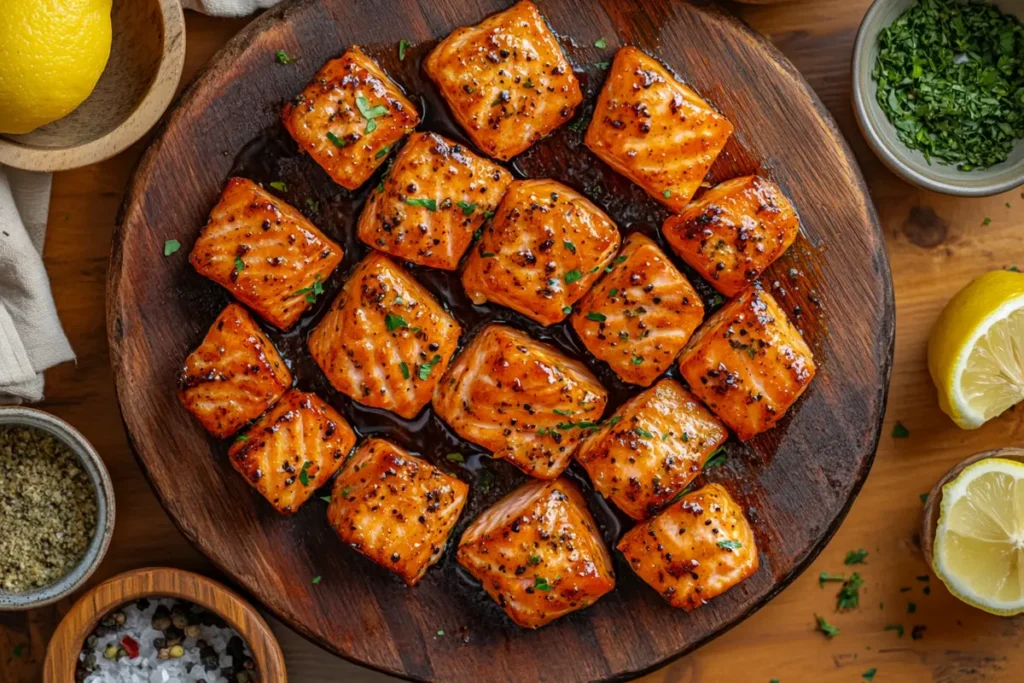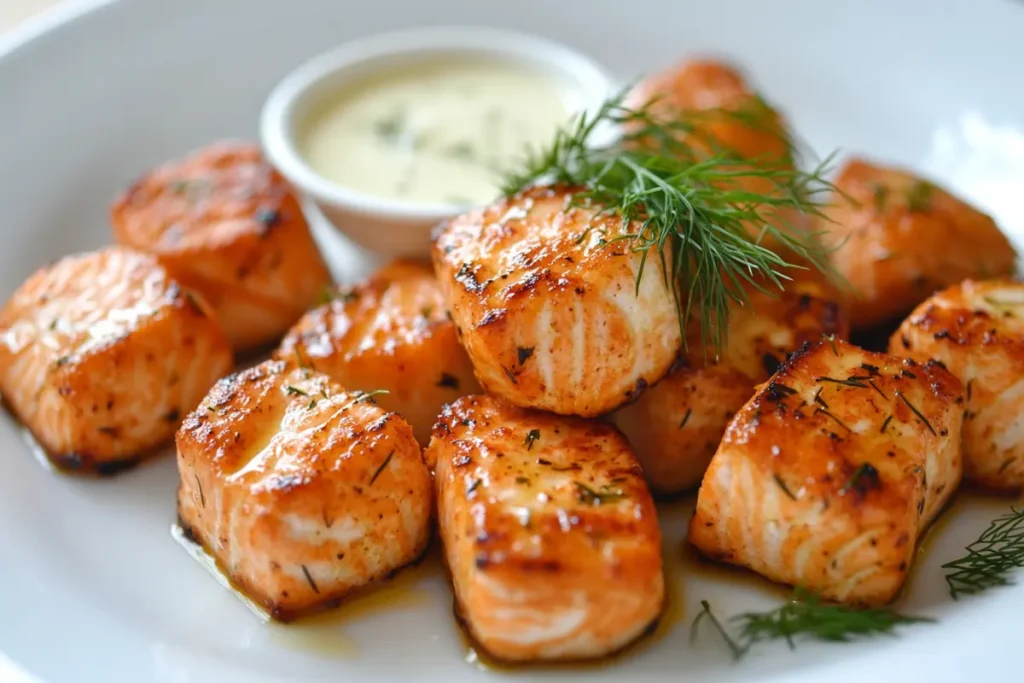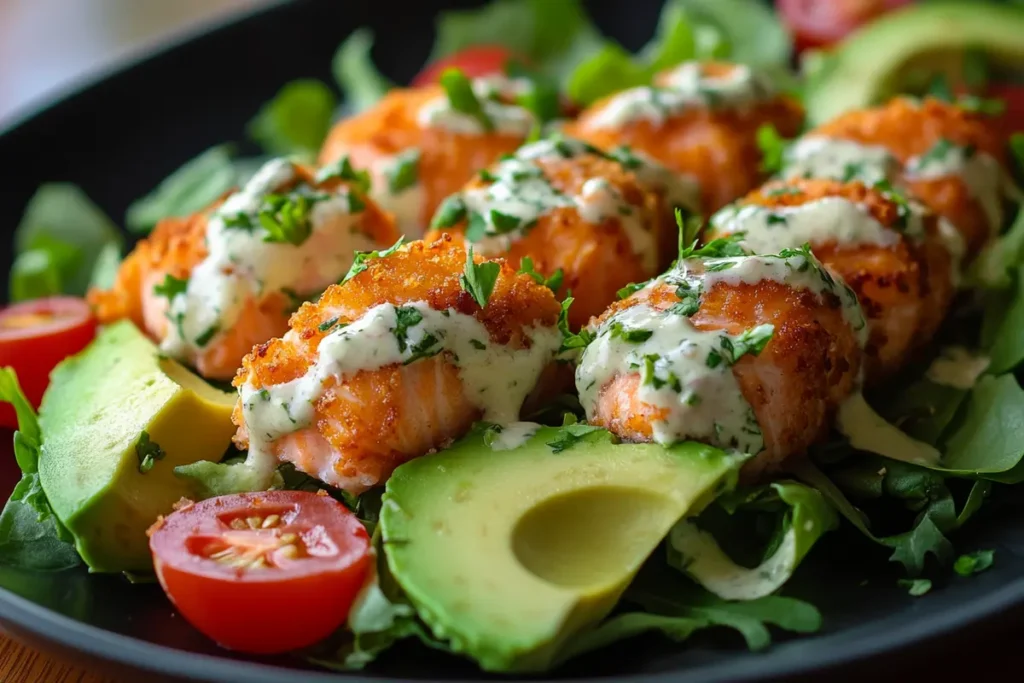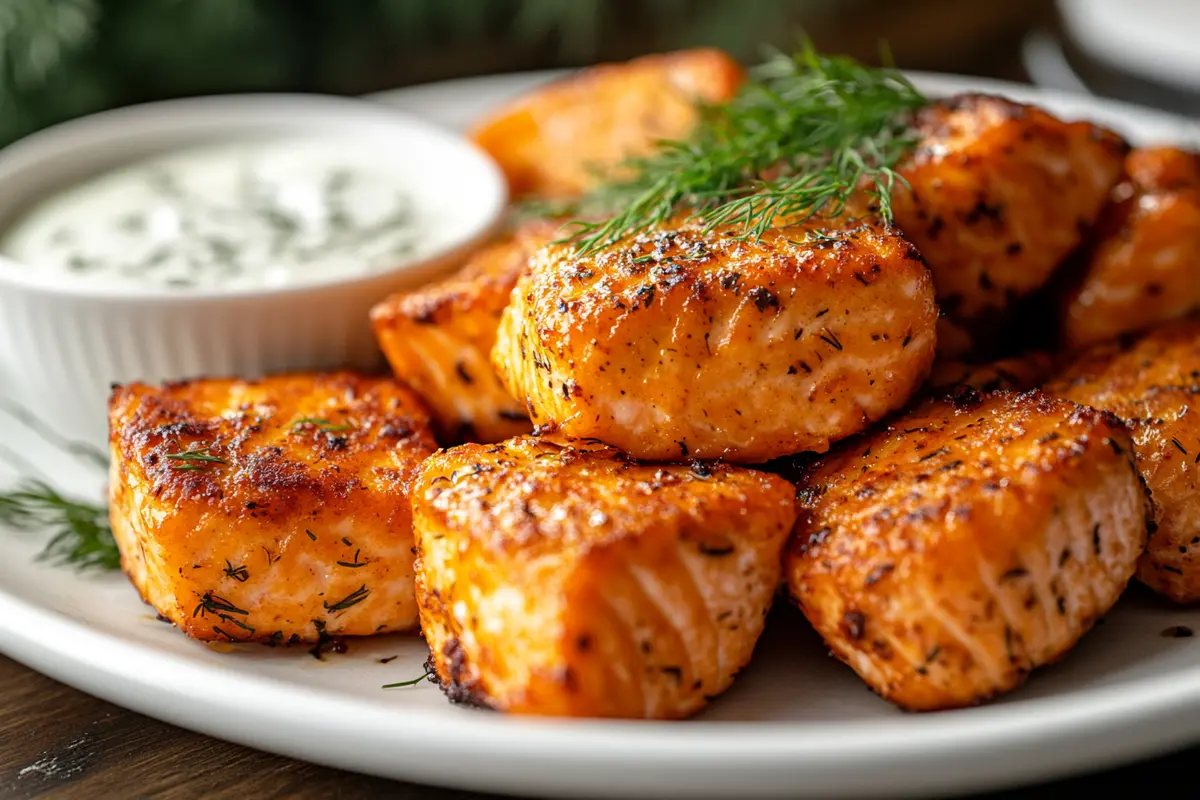Salmon bites are a delightful culinary treat, offering a unique way to enjoy one of nature’s most nutritious fish. These bite-sized salmon pieces are quick to prepare, incredibly versatile, and brimming with flavor. Whether you’re looking for an appetizer, snack, or main course, salmon bites make a perfect addition to any menu. In this article, we’ll explore everything you need to know to create the best salmon bites recipe from choosing the right salmon to mastering various cooking techniques and pairing ideas. Let’s dive in and start with the basics.
What Are Salmon Bites ?
Understanding Salmon Bites
Salmon bites are small, bite-sized portions of salmon, often marinated or seasoned to perfection. These flavorful pieces are cooked using various methods such as pan-searing, baking, or air frying. Popular for their ease of preparation, they are loved for their rich, flaky texture and ability to absorb flavors beautifully. Whether served solo or accompanied by dips, they’re a hit at every occasion.
Why Salmon Bites Are Trending
It’s no surprise that salmon bites recipes have skyrocketed in popularity. Packed with nutrients, these savory treats are not only delicious but also align with healthy eating trends. Salmon’s versatility allows it to adapt to different cuisines, making it a crowd-pleaser. Moreover, their small size ensures quick cooking and easy portioning, making them ideal for busy weeknights or spontaneous gatherings.
A Versatile Option for Every Occasion
Salmon bites fit seamlessly into diverse culinary settings. Whether they’re used as appetizers at a dinner party, a quick snack during a busy day, or part of a wholesome family meal, they always bring something special to the table. From sweet and spicy to tangy and savory, the possibilities for seasoning and pairing are endless, keeping your menu fresh and exciting.
Health Benefits of Salmon
Nutritional Profile of Salmon
Salmon is a nutritional powerhouse, loaded with essential nutrients that promote overall well-being. A single 3.5-ounce (100-gram) serving of salmon is rich in high-quality protein, omega-3 fatty acids, and an array of vitamins and minerals. These nutrients play a crucial role in maintaining muscle health, supporting brain function, and boosting energy levels.
What makes salmon stand out is its perfect balance of fats and proteins. Unlike other protein sources, salmon provides healthy fats that are essential for brain and heart health, along with an impressive array of micronutrients like vitamin D, selenium, and potassium. These elements work together to reduce inflammation, enhance bone strength, and regulate blood pressure. Truly, adding salmon to your diet is a smart way to nourish your body while savoring its exquisite taste.
Omega-3 Fatty Acids and Heart Health
Omega-3 fatty acids are a hallmark of salmon’s nutritional value, known for their incredible health benefits. These fats, primarily EPA (eicosapentaenoic acid) and DHA (docosahexaenoic acid), are essential for cardiovascular well-being. They help lower blood pressure, reduce triglycerides, and improve the elasticity of arteries.
But that’s not all—omega-3s also exhibit anti-inflammatory properties, protecting against chronic diseases like arthritis and autoimmune disorders. Studies have shown that consuming fatty fish, such as salmon, at least twice a week can significantly reduce the risk of heart disease. So, if you’re looking for a delicious way to support your heart, incorporating salmon bites into your meal plan is a no-brainer.
Vitamins and Minerals in Salmon
Packed with an impressive lineup of vitamins and minerals, salmon is a nutrient-dense food that supports various bodily functions. The B vitamins (B1, B2, B3, B5, B6, B9, and B12) found in salmon contribute to energy production, brain health, and the formation of red blood cells.
Additionally, salmon is an excellent source of vitamin D, a nutrient essential for bone health and immune system function. This is especially important for individuals who have limited sun exposure. Selenium, another vital component, acts as a powerful antioxidant, protecting cells from damage and supporting thyroid health.
Potassium in salmon helps maintain proper fluid balance, nerve signaling, and muscle contractions. Together, these nutrients make salmon not only a culinary delight but also a vital ingredient for optimal health.
Selecting the Right Salmon
Wild-Caught vs. Farm-Raised Salmon
When choosing salmon for your salmon bites recipe, the debate between wild-caught and farm-raised varieties often arises. Wild-caught salmon typically comes from natural habitats like oceans and rivers, offering a leaner texture and a robust, rich flavor. It also tends to have fewer contaminants, making it a preferred choice for health-conscious individuals.
Farm-raised salmon, on the other hand, is cultivated in controlled environments. While it’s more affordable and widely available, it may contain higher fat levels and potentially more exposure to additives or antibiotics. That said, advances in farming practices have improved the quality of farm-raised salmon, making it a viable option for many.
Ultimately, the choice depends on your preferences, budget, and access to reliable sources. Opting for high-quality salmon, regardless of its origin, ensures your bites are both tasty and nutritious.
Fresh vs. Frozen Salmon
Both fresh and frozen salmon are excellent options for crafting delectable salmon chunks. Fresh salmon is prized for its superior texture and flavor, making it ideal for recipes that require minimal seasoning or cooking. However, its shorter shelf life and higher price point can be drawbacks.
Frozen salmon, by contrast, offers convenience and longevity. Thanks to modern freezing techniques, frozen salmon retains most of its nutrients and flavor, making it a practical choice for busy cooks. To ensure quality, look for vacuum-sealed packages with minimal ice crystals. Thawing the salmon properly before cooking—preferably in the refrigerator overnight—helps maintain its integrity.
Whichever option you choose, prioritize sourcing salmon from reputable vendors to ensure freshness and safety.
Sustainable Seafood Choices
With increasing awareness about the importance of sustainability, choosing eco-friendly seafood options is a significant step toward protecting marine ecosystems. Sustainably sourced salmon is harvested in ways that minimize environmental impact, preserve fish populations, and ensure the health of the habitat.
Look for certifications such as the Marine Stewardship Council (MSC) or the Aquaculture Stewardship Council (ASC) when purchasing salmon. These labels indicate adherence to sustainable fishing and farming practices. Additionally, opting for local and seasonal salmon varieties can further reduce your carbon footprint.
By making informed choices, you’re not only enjoying delicious salmon bites but also contributing to a healthier planet. It’s a win-win situation for you and the environment!
Preparing Salmon for Cooking
How to Properly Cut Salmon into Bite-Sized Pieces
Preparation is key when crafting perfect salmon bites. Start with a high-quality salmon fillet, ensuring it’s fresh or properly thawed if frozen. Lay the fillet on a clean cutting board and use fish tweezers to carefully remove any pin bones. Next, separate the skin from the flesh by sliding a sharp knife between them, keeping the blade angled slightly downward for clean removal.
With the skin removed, cut the salmon into uniform 1-inch cubes. This ensures that each piece cooks evenly, delivering a consistent texture and flavor. Avoid cutting the pieces too small, as this can make them prone to overcooking. Precision is your ally here—clean cuts not only improve cooking but also elevate presentation.
Marinating Techniques for Enhanced Flavor
A good marinade is the secret to transforming simple salmon chunks into flavor-packed bites. Combine ingredients such as soy sauce, honey, garlic, and fresh ginger for an Asian-inspired marinade, or opt for olive oil, lemon juice, dill, and minced garlic for a Mediterranean twist. Whisk the ingredients together and pour them over the salmon in a shallow dish or ziplock bag.
Allow the salmon to marinate for at least 30 minutes, letting the flavors fully infuse the fish. If time permits, longer marinating (up to 2 hours) can deepen the taste even more. Avoid marinating overnight, as the acidic components can start to break down the salmon’s texture. Once marinated, pat the bites dry before cooking to ensure a perfect sear or crisp finish.
Seasoning Options for Salmon Bites
For those who prefer dry seasonings, the possibilities are endless. Classic combinations like smoked paprika, garlic powder, black pepper, and a pinch of cayenne deliver a smoky and slightly spicy profile. If you’re looking for something more zesty, try lemon zest, dill, and a sprinkle of sea salt.
For a touch of sweetness, a light coat of brown sugar mixed with chili powder can work wonders. These seasonings not only complement the natural flavors of salmon but also caramelize beautifully during cooking. Experimenting with spice blends allows you to tailor the dish to suit your preferences, keeping every bite exciting.
Cooking Methods for Salmon Bites
Pan-Searing Salmon Bites
Pan-searing is one of the quickest and most flavorful ways to cook salmon bites. Heat a non-stick or cast-iron skillet over medium-high heat and add a tablespoon of oil, such as avocado or olive oil, for a light, crispy finish.
Once the oil is shimmering, gently place the salmon pieces into the pan, ensuring they’re not crowded. Let them sear undisturbed for about 2-3 minutes on each side, or until they develop a golden crust. Avoid flipping too early to prevent sticking. This method locks in the fish’s juices while adding a slightly crispy texture. Serve immediately to enjoy the bites at their peak flavor.

Baking Salmon Bites
Baking offers a fuss-free method to cook salmon bites to tender perfection. Begin by preheating your oven to 400°F (200°C). Line a baking sheet with parchment paper or lightly grease it to prevent sticking. Arrange the seasoned or marinated salmon bites evenly on the sheet, ensuring there’s space between each piece for proper airflow.
Bake for 10-12 minutes, depending on the size of the bites. You’ll know the salmon is ready when it flakes easily with a fork and reaches an internal temperature of 145°F (63°C). For an added touch, broil the bites for 1-2 minutes at the end to achieve a lightly crisp exterior.
Air Frying for a Healthier Option
Air frying is a fantastic way to achieve crispy salmon bites with minimal oil. Preheat your air fryer to 400°F (200°C) and lightly spray the basket with cooking oil to prevent sticking. Arrange the salmon bites in a single layer, making sure not to overcrowd them.
Cook for 6-8 minutes, shaking the basket halfway through to ensure even crisping. The result is a batch of salmon bites that are crispy on the outside and tender on the inside. Air frying not only cuts down on calories but also delivers a delightful crunch, making it a favorite for health-conscious eaters.
Popular Salmon Bites Recipes
Honey Garlic Salmon Bites
For those craving a perfect blend of sweet and savory, honey garlic salmon bites are a must-try. Begin by preparing a sauce with equal parts honey, soy sauce, and fresh minced garlic. Heat the mixture in a skillet until slightly thickened, then add your salmon bites, ensuring they’re evenly coated.
Cook the bites over medium heat for 4-6 minutes, turning occasionally, until the sauce caramelizes and clings to the salmon. The result? Tender, flavorful bites that burst with a delightful mix of sweetness and umami. These bites pair wonderfully with steamed rice or sautéed green beans, making them an ideal choice for a quick, satisfying dinner.

Bang Bang Salmon Bites
Inspired by the ever-popular Bang Bang sauce, this recipe takes salmon bites to a new level. Start by coating the salmon chunks in a light breading mixture made from cornstarch and flour. Air fry or bake the pieces until crispy.
The magic lies in the sauce: a blend of mayonnaise, sweet chili sauce, and a hint of sriracha for spice. Toss the crispy salmon bites in the sauce until they’re fully coated. Serve these delectable bites as an appetizer or over a bed of greens for a creative salad. Find the full recipe for this irresistible treat at I Heart Umami.
Spicy Salmon Bites with Avocado Lime Sauce
If you’re a fan of bold flavors, these spicy salmon bites will not disappoint. Rub the salmon chunks with a mixture of chili powder, smoked paprika, garlic powder, and a pinch of cayenne. Air fry the bites at 400°F (200°C) for 6-8 minutes, shaking the basket halfway through for even cooking.
The avocado lime sauce is the perfect cooling counterpart to the spice. Blend ripe avocado, fresh lime juice, cilantro, and a touch of Greek yogurt until smooth. Drizzle the sauce over the salmon bites or serve it on the side for dipping. For the complete recipe, visit Allrecipes.

Serving Suggestions
Pairing Salmon Bites with Sides
A good side dish can elevate salmon bites recipes from great to unforgettable. For a nutritious and hearty meal, pair the bites with a fluffy quinoa salad, tossed with cucumbers, cherry tomatoes, and a light lemon vinaigrette.
Roasted vegetables like asparagus, broccoli, or Brussels sprouts are another excellent option, offering a rich, caramelized flavor that complements the salmon’s savoriness. If you’re in the mood for something light, mixed greens with a citrusy dressing can provide a refreshing contrast.
For an added touch, consider serving the salmon bites on a bed of wild rice or alongside creamy mashed sweet potatoes. These sides not only enhance the taste but also add a pleasing textural contrast, turning your meal into a balanced culinary experience.

